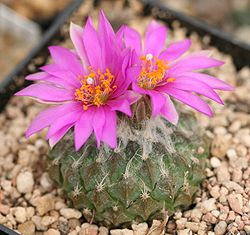| Pelecyphora strobiliformis | |
|---|---|
 | |
| Scientific classification | |
| Kingdom: | Plantae |
| Clade: | Tracheophytes |
| Clade: | Angiosperms |
| Clade: | Eudicots |
| Order: | Caryophyllales |
| Family: | Cactaceae |
| Subfamily: | Cactoideae |
| Genus: | Pelecyphora |
| Species: | P. strobiliformis |
| Binomial name | |
| Pelecyphora strobiliformis | |
| Synonyms | |
| |
Pelecyphora strobiliformis is a species of cactus from Mexico. [3] Its numbers in the wild have been reduced by collecting; it is listed in Appendix I of CITES [3] (meaning that international trade is severely controlled) but only as of "Least Concern" by the IUCN. [4]


